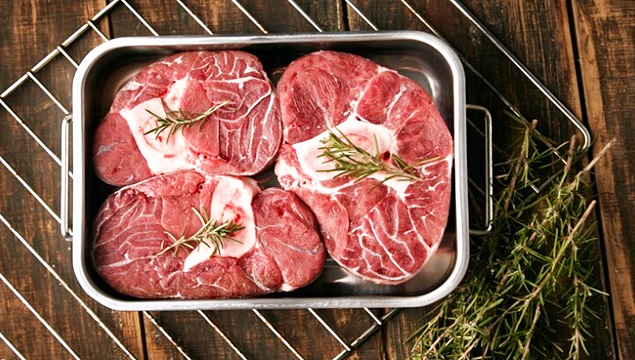
Meat and meat products are excellent sources of nutrients for humans. However, they also provide a favorable environment for microbial growth. In order to prevent microbial contamination of food, synthetic preservatives, including nitrites, nitrates, and sorbates, have been widely used in the food industry due to their low cost and strong antibacterial activity. One such study is "Application of Natural Preservatives for Meat and Meat Products against Food-Borne Pathogens and Spoilage Bacteria," authored by Oscar Lopez-Campos, Nuria Prieto Benavides, and Jose Manuel Lorenzo Rodriguez from the University of Barcelona, from which we present the most important extracts.
Health concerns
The use of synthetic chemical preservatives has recently been taken into consideration by consumers due to concerns about negative health issues. Therefore, the demand for natural substances as food preservatives has increased with the use of plant and animal-derived products and microbial metabolites.
These natural preservatives inhibit the growth of spoilage microorganisms or foodborne pathogens by increasing the permeability of microbial cell membranes, disrupting protein synthesis, and cellular metabolism. Natural preservatives can extend the shelf life and inhibit the growth of microorganisms.
However, they can also influence the sensory properties of food, including aroma, taste, color, texture, and acceptability. In order to enhance the applicability of natural preservatives, a number of strategies have been explored, including combinations of different preservatives or food preservation methods such as active packaging systems and encapsulation.
600 million sick!
Foodborne pathogens, including Listeria monocytogenes, Staphylococcus aureus, pathogenic Escherichia coli, Clostridium perfringens, Campylobacter spp., and Vibrio spp., cause a significant number of illnesses with substantial damage to human health and the economy.
According to the World Health Organization (WHO), food contaminated with pathogens, chemicals, and foodborne allergens leads to 600 million cases of foodborne illnesses and approximately four hundred thousand deaths worldwide each year. Additionally, fifty-six million people die each year, and approximately 7.7% of the global population suffers from foodborne diseases.
Meat and meat products are essential sources of nutrients for humans due to their excellent protein content, essential amino acids, B-group vitamins, and minerals. However, meat and meat products also provide a suitable environment for spoilage microorganisms or foodborne pathogens due to their high water activity and nutrient factors.
An increased threat
The global food industry has advanced, resulting in an increased threat of food contamination with pathogenic microorganisms, chemical residues, harmful food additives, and toxins. The proliferation of spoilage and pathogenic microorganisms should be controlled to ensure food safety.
As a result, food preservation techniques to protect food from pathogenic bacteria and extend its shelf life include chemical methods such as the use of preservatives, physical methods such as heat treatment, drying, freezing, and packaging, as well as biological methods that utilize microorganisms with an antagonistic effect against pathogenic bacteria and produce bacteriocins. Among these, the addition of food preservatives that inhibit the growth of microorganisms is a widely used food protection technique.
Each country has different regulations for food preservatives. Synthetic preservatives have advantages in meat processing due to their low cost, guaranteed antibacterial effect or extended shelf life, and minimal impact on taste, aroma, color, and texture.
However, synthetic preservatives tend to be less preferred by food consumers due to a range of health concerns regarding their side effects. Sorbic acid, benzoic acid, and their salts have been reported to promote mutagenic and carcinogenic compounds. Nitrites and nitrates, used as preservatives and colorants in meat, have been associated with leukemia, colon cancer, bladder cancer, and others.
Alternatives to synthetic preservatives
Natural preservatives have shown their potential to provide effective antimicrobial activity while reducing negative health effects. Meat and meat products containing synthetic additives are a major concern for human health.
Therefore, meat producers and researchers have started considering the use of natural preservatives rather than synthetic ones. Representative of this trend is the clean label food movement, including meat and meat products, which started in the UK in the 1990s and has become a significant marketing source. It includes consumer-friendly features such as no synthetic additives, minimal processing, a short list of food ingredients, and traditional production methods.
In particular, the clean label food ingredients market, including natural preservatives, is projected to reach a value of $47.50 billion by 2023, mainly due to increasing consumer demand for natural products. In some countries, natural preservatives such as nisin, natamycin, ε-polylysine, and grapefruit seed extract are registered but not approved for use in meat products, or their concentration is not specified.
Replacing synthetic preservatives with natural alternatives has major positive effects and is well-received by consumers. However, food manufacturers also face challenges, including decreased price competitiveness due to the relatively higher cost of natural preservatives and reduced antibacterial efficacy due to food ingredients such as carbohydrates, proteins, and lipids.
In the case of plant-derived substances, standardization is problematic due to the influence of country of origin, soil, and harvest season. Furthermore, toxicity evaluation or identification of specific compounds for various plant-derived compounds contained in extracts and essential oils is needed.
To address these issues, various studies have been conducted to optimize the extraction process, combine other antimicrobial substances, apply active packaging, and encapsulate antibacterial agents to enhance their utilization.
Essential oils
Natural preservatives are manufactured in a variety of formulations, including powder formed by drying methods and liquid forms such as essential oils. Natural preservatives are added directly to meat products and extend shelf life by inhibiting bacterial growth. In addition, it is possible to increase the antibacterial effect of natural preservatives through a combination of other food processing methods.
In the case of natural preservatives derived from plants, it is necessary to consider the form applied to the food. They are usually prepared as extracts using organic solvents, water and essential oils. Plant extracts obtained from rosemary, chestnut, sage, cranberry, oregano, grape seeds and others were used as meat preservatives.
Many studies have been conducted to apply plant-derived substances to meat products in the form of essential oil because the antibacterial effect of the essential oil type is better than that of the extract type. However, it is difficult to apply large amounts of essential oil to food because of its distinct organoleptic properties.
Recent developments have tried to solve this problem by applying essential oils with other antibacterial substances. The advantage of this application is that it reduces the amounts of strong-smelling essential oils and increases the antioxidant and antibacterial effects through synergistic effects.
From an industrial point of view, if synthetic preservatives cannot be completely replaced by natural preservatives, due to industrial problems such as increasing economic costs or the complexity of the product manufacturing process, they could be gradually replaced by making up a mixed formulation of synthetic preservatives and natural preservatives.
Meat treatment by irradiation
Gamma irradiation treatment and high pressure processing (HPP) are physical methods of food processing that can further increase the antibacterial effectiveness of natural preservatives. Unlike thermal food processing, these two food processing techniques could be used for pasteurization of raw meat because it has a minor effect on food composition.
In 1997, the WHO, the Food and Agriculture Organization (FAO), and the International Atomic Energy Agency (IAEA) concluded that foods processed with adequate doses of irradiation are nutritionally sufficient and safe for consumption. Currently, irradiation is permitted for food preservation in more than sixty countries.
Recent approaches in food irradiation have involved the use of combined treatments with natural preservatives to reduce irradiation doses. In previous studies, gamma irradiation of medium doses (2-6 kGy) with natural compounds and active packaging was applied to extend the shelf life of meat and meat products.
HPP is also a non-thermal food preservation technique that inhibits the growth of microorganisms and maintains the natural properties of the food. In general, HPP is carried out at high pressures (100–800 MPa) at mild temperature or weak heating.
Previous studies have reported the potential ability of combining HPP and natural preservatives, including essential oil and antibacterial peptides, in mitigating both processing conditions. of HPP and the concentration of natural preservatives while maintaining the antibacterial effects.
Encapsulation
Encapsulation is one of the effective approaches for extending the applicability of natural preservatives in food. Encapsulation has been performed using Generally Recognized as Safe (GRAS) materials such as alginate, chitosan, starch, dextrin, and proteins, employing various techniques including spray drying, extrusion, lyophilization, coacervation, and emulsification.
The application of natural preservatives in meat is limited due to their characteristics such as low solubility and bioavailability, rapid release, and easy degradation. Additionally, environmental conditions such as pH, temperature, storage time, exposure to oxygen and light can influence the effectiveness of natural preservatives.
Through encapsulation, natural preservatives, especially hydrophobic compounds (e.g., essential oils), can improve their stability and enhance the versatility of food processing while maintaining their antibacterial effect.
Active Packaging
Active packaging is an innovative packaging technology that allows interaction with the product and its environment to extend shelf life and ensure microbial safety while preserving the original properties of the packaged food.
According to the European Union Guidelines to Commission Regulation (EUGCR), active packaging is a type of food packaging with an additional beneficial function, providing a protective barrier against external influences.
In the meat industry, antimicrobial active packaging can be applied through several methods, including incorporating natural preservatives in a sachet inside the packaging, incorporating natural preservatives into the composition of the packaging film, coating the packaging with natural preservatives on the surface of the food, and using antimicrobial polymers as packaging materials.
Bioconservation
Bioconservation, the application of natural preservatives derived from microorganisms, also known as biopreservation, where beneficial microorganisms or their antibacterial substances have antagonistic effects on pathogenic or spoilage microorganisms, is gaining attention in meat preservation.
This method primarily involves lactic acid bacteria, such as Lactobacillus spp., Leuconostoc spp., Pediococcus spp., and Lactococcus spp., which have Generally Recognized as Safe (GRAS) status, widely participate in fermentation processes, and produce various antibacterial metabolites, such as organic acids, hydrogen peroxide, and bacteriocins.
Regarding the application in meat products, bioconservation methods have included direct inoculation with lactic acid bacteria, which have an inhibitory effect on spoilage or pathogenic bacteria, incorporation of bacterial strains producing antimicrobial substances into the fermentation starter, and treatment with purified bacteriocins.
Natural plant preservatives
The antibacterial effect of natural preservatives derived from plants is closely related to polyphenols, phenolics and flavonoids. Plant-derived polyphenols have different classifications and structures, as follows:
phenolic acids (caffeic acid, rosmarinic acid, gallic acid, ellagic acid, cinnamic acid), flavones (luteolin, apigenin, chrysoeriol), flavanols (catechin, epicatechin, epigallocatechin, gallocatechin, and their gallate derivatives), flavanones (hesperidin, hesperetin, heridictyol, naringenin), flavonols (quercetin, kaempferol, myricetin), isoflavones (geinstein, daidzin, formononetin), coumarins (coumarin, warfarin, 7-hydroxycoumarin), anthocyanins (pelagonidins), delphinidin, cyanidin, malvidin), quinones ( naphthoquinones, hypericin), alkaloids (caffeine, berberine, harmana) and terpenoids (menthol, thymol, lycopene, capsaicin, linalool).
Polyphenols have been recognized for their effective antimicrobial properties. Although the antimicrobial mechanism has not yet been clearly elucidated, previous studies have reported the following:
(1) molecules that disrupt the cell membrane, such as the hydroxy group (OH-), which induces leakage of intracellular components, inactivation of metabolic enzymes, and quenching of the adenosine triphosphate (ATP) structure;
(2) directly changing the pH in the environment by improving the concentration of protons, reducing the intracellular pH by dissociating acid molecules and changing the permeability of the bacterial membrane;
(3) an organic acid in plant extracts can influence the oxidation of nicotinamide adenine dinucleotide (NADH), thereby eliminating the reducing agent used in the electron transport system.




